Nestle Project: HR Recruitment, Selection, and Training
VerifiedAdded on 2023/01/16
|24
|4071
|82
Project
AI Summary
This project delves into how multinational corporations, specifically Nestle, can enhance their recruitment, selection, and training practices to meet international standards. The project begins by outlining the objectives, scope, and a project management plan (PMP) which covers cost, time frame, quality, communication, risk, and resources. It then builds a Work Breakdown Structure (WBS) and a Gantt chart to clarify project timelines and task completion. The research methodology incorporates both qualitative and quantitative research methods, including primary and secondary data collection through questionnaires. The project evaluates the research findings, providing recommendations for Nestle to improve its HR practices and ultimately achieve its goals. The project concludes with a reflection on the research process and its alignment with the project's objectives.
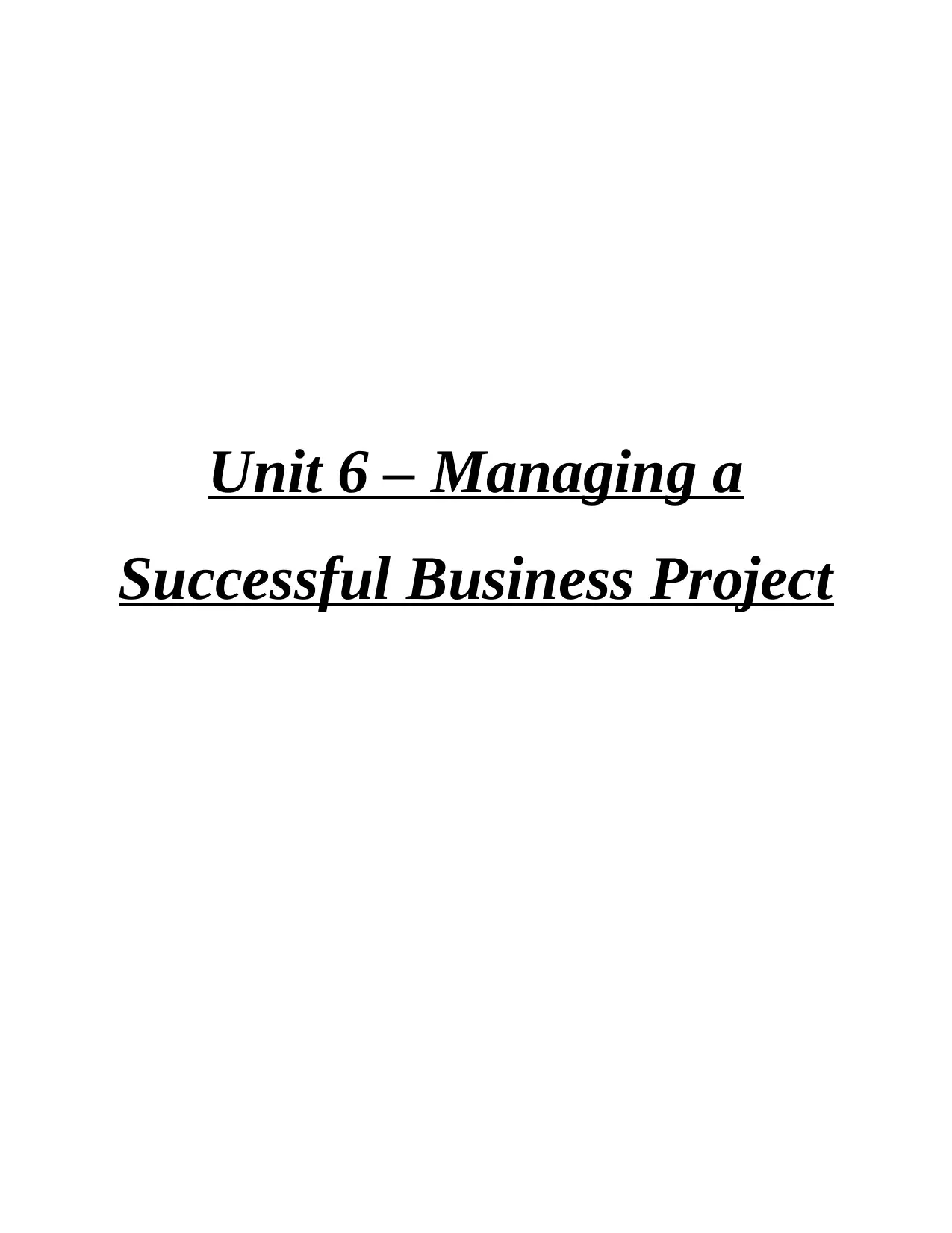
Unit 6 – Managing a
Successful Business Project
Successful Business Project
Paraphrase This Document
Need a fresh take? Get an instant paraphrase of this document with our AI Paraphraser
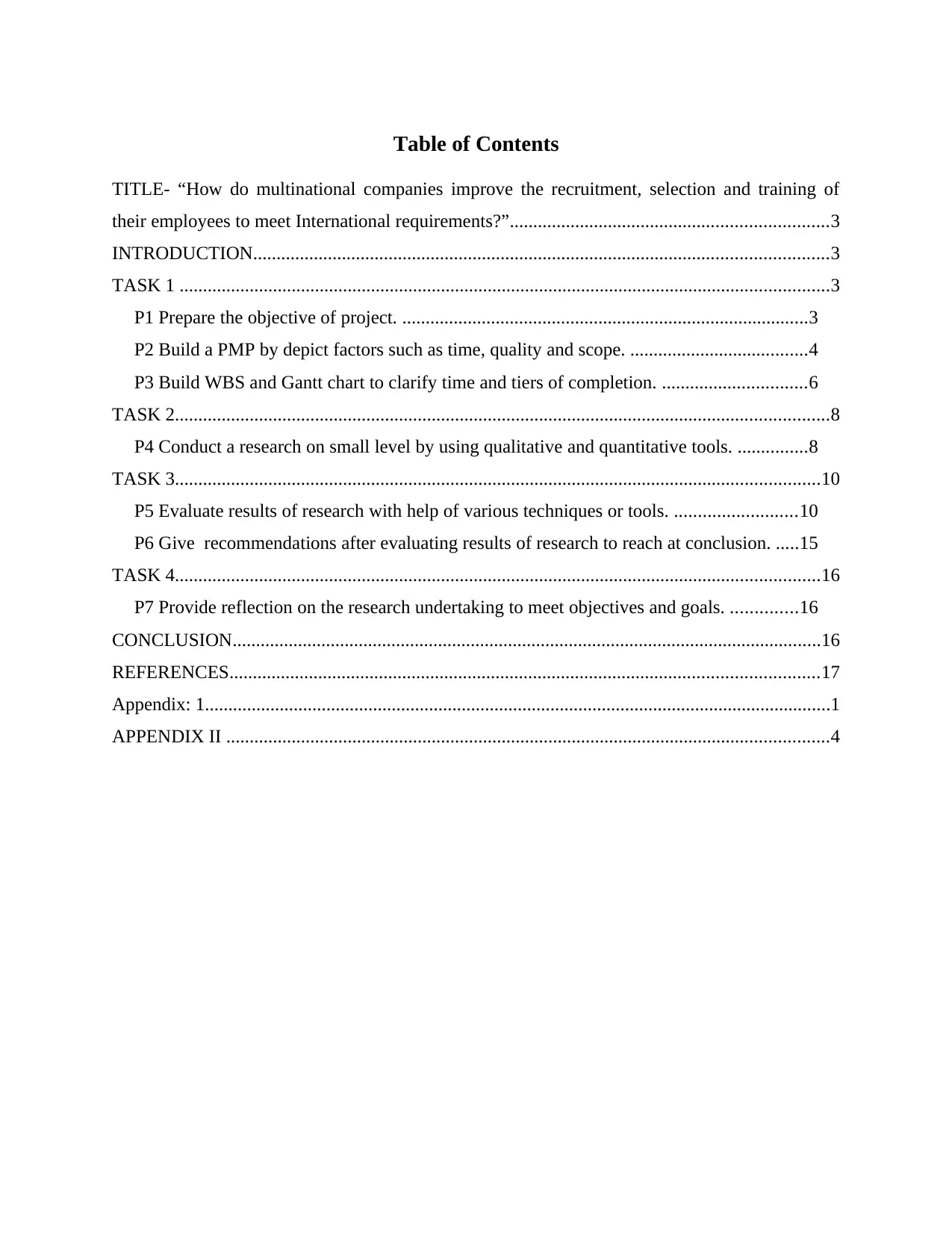
Table of Contents
TITLE- “How do multinational companies improve the recruitment, selection and training of
their employees to meet International requirements?”....................................................................3
INTRODUCTION...........................................................................................................................3
TASK 1 ...........................................................................................................................................3
P1 Prepare the objective of project. .......................................................................................3
P2 Build a PMP by depict factors such as time, quality and scope. ......................................4
P3 Build WBS and Gantt chart to clarify time and tiers of completion. ...............................6
TASK 2............................................................................................................................................8
P4 Conduct a research on small level by using qualitative and quantitative tools. ...............8
TASK 3..........................................................................................................................................10
P5 Evaluate results of research with help of various techniques or tools. ..........................10
P6 Give recommendations after evaluating results of research to reach at conclusion. .....15
TASK 4..........................................................................................................................................16
P7 Provide reflection on the research undertaking to meet objectives and goals. ..............16
CONCLUSION..............................................................................................................................16
REFERENCES..............................................................................................................................17
Appendix: 1......................................................................................................................................1
APPENDIX II .................................................................................................................................4
TITLE- “How do multinational companies improve the recruitment, selection and training of
their employees to meet International requirements?”....................................................................3
INTRODUCTION...........................................................................................................................3
TASK 1 ...........................................................................................................................................3
P1 Prepare the objective of project. .......................................................................................3
P2 Build a PMP by depict factors such as time, quality and scope. ......................................4
P3 Build WBS and Gantt chart to clarify time and tiers of completion. ...............................6
TASK 2............................................................................................................................................8
P4 Conduct a research on small level by using qualitative and quantitative tools. ...............8
TASK 3..........................................................................................................................................10
P5 Evaluate results of research with help of various techniques or tools. ..........................10
P6 Give recommendations after evaluating results of research to reach at conclusion. .....15
TASK 4..........................................................................................................................................16
P7 Provide reflection on the research undertaking to meet objectives and goals. ..............16
CONCLUSION..............................................................................................................................16
REFERENCES..............................................................................................................................17
Appendix: 1......................................................................................................................................1
APPENDIX II .................................................................................................................................4
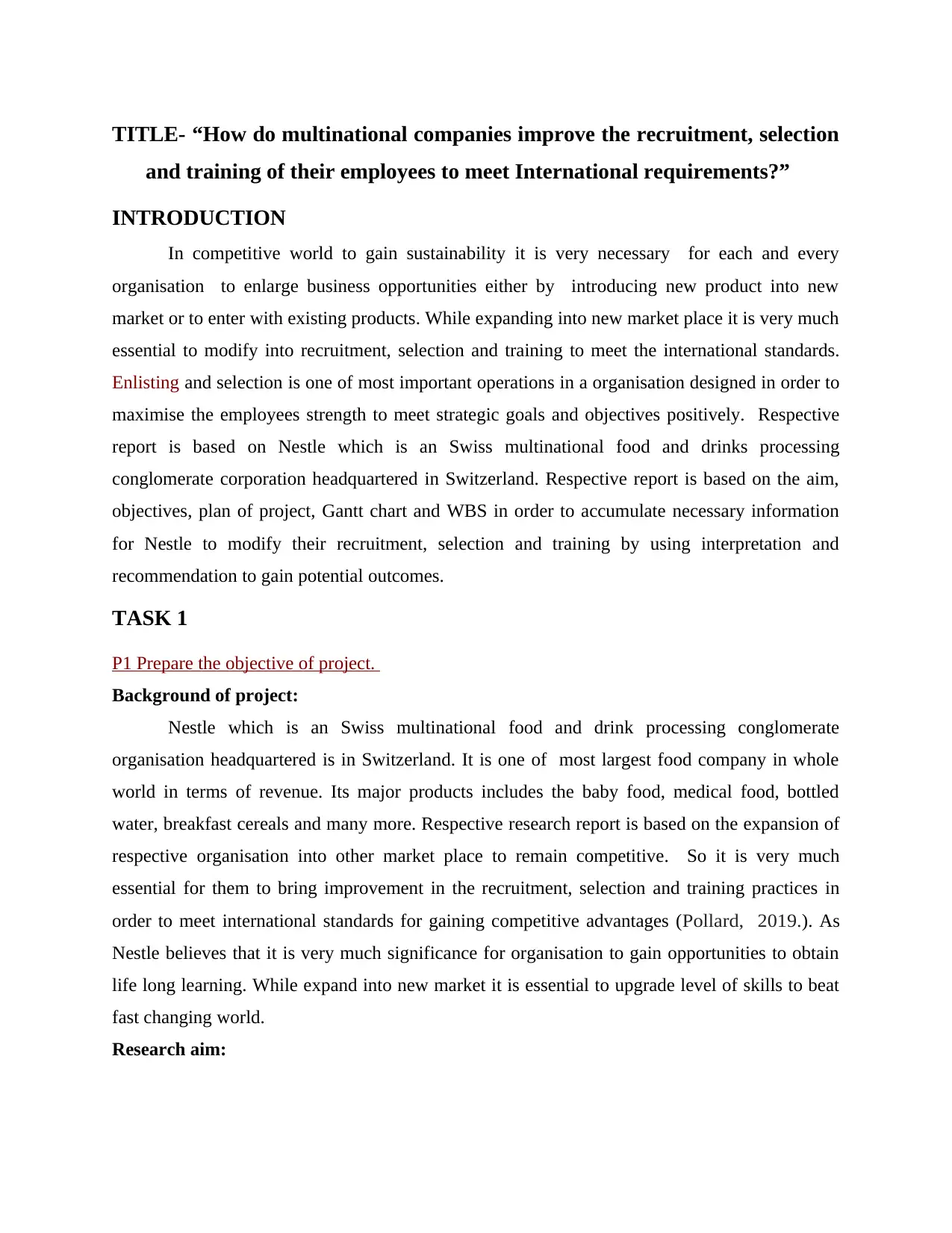
TITLE- “How do multinational companies improve the recruitment, selection
and training of their employees to meet International requirements?”
INTRODUCTION
In competitive world to gain sustainability it is very necessary for each and every
organisation to enlarge business opportunities either by introducing new product into new
market or to enter with existing products. While expanding into new market place it is very much
essential to modify into recruitment, selection and training to meet the international standards.
Enlisting and selection is one of most important operations in a organisation designed in order to
maximise the employees strength to meet strategic goals and objectives positively. Respective
report is based on Nestle which is an Swiss multinational food and drinks processing
conglomerate corporation headquartered in Switzerland. Respective report is based on the aim,
objectives, plan of project, Gantt chart and WBS in order to accumulate necessary information
for Nestle to modify their recruitment, selection and training by using interpretation and
recommendation to gain potential outcomes.
TASK 1
P1 Prepare the objective of project.
Background of project:
Nestle which is an Swiss multinational food and drink processing conglomerate
organisation headquartered is in Switzerland. It is one of most largest food company in whole
world in terms of revenue. Its major products includes the baby food, medical food, bottled
water, breakfast cereals and many more. Respective research report is based on the expansion of
respective organisation into other market place to remain competitive. So it is very much
essential for them to bring improvement in the recruitment, selection and training practices in
order to meet international standards for gaining competitive advantages ( Pollard, 2019.). As
Nestle believes that it is very much significance for organisation to gain opportunities to obtain
life long learning. While expand into new market it is essential to upgrade level of skills to beat
fast changing world.
Research aim:
and training of their employees to meet International requirements?”
INTRODUCTION
In competitive world to gain sustainability it is very necessary for each and every
organisation to enlarge business opportunities either by introducing new product into new
market or to enter with existing products. While expanding into new market place it is very much
essential to modify into recruitment, selection and training to meet the international standards.
Enlisting and selection is one of most important operations in a organisation designed in order to
maximise the employees strength to meet strategic goals and objectives positively. Respective
report is based on Nestle which is an Swiss multinational food and drinks processing
conglomerate corporation headquartered in Switzerland. Respective report is based on the aim,
objectives, plan of project, Gantt chart and WBS in order to accumulate necessary information
for Nestle to modify their recruitment, selection and training by using interpretation and
recommendation to gain potential outcomes.
TASK 1
P1 Prepare the objective of project.
Background of project:
Nestle which is an Swiss multinational food and drink processing conglomerate
organisation headquartered is in Switzerland. It is one of most largest food company in whole
world in terms of revenue. Its major products includes the baby food, medical food, bottled
water, breakfast cereals and many more. Respective research report is based on the expansion of
respective organisation into other market place to remain competitive. So it is very much
essential for them to bring improvement in the recruitment, selection and training practices in
order to meet international standards for gaining competitive advantages ( Pollard, 2019.). As
Nestle believes that it is very much significance for organisation to gain opportunities to obtain
life long learning. While expand into new market it is essential to upgrade level of skills to beat
fast changing world.
Research aim:
⊘ This is a preview!⊘
Do you want full access?
Subscribe today to unlock all pages.

Trusted by 1+ million students worldwide
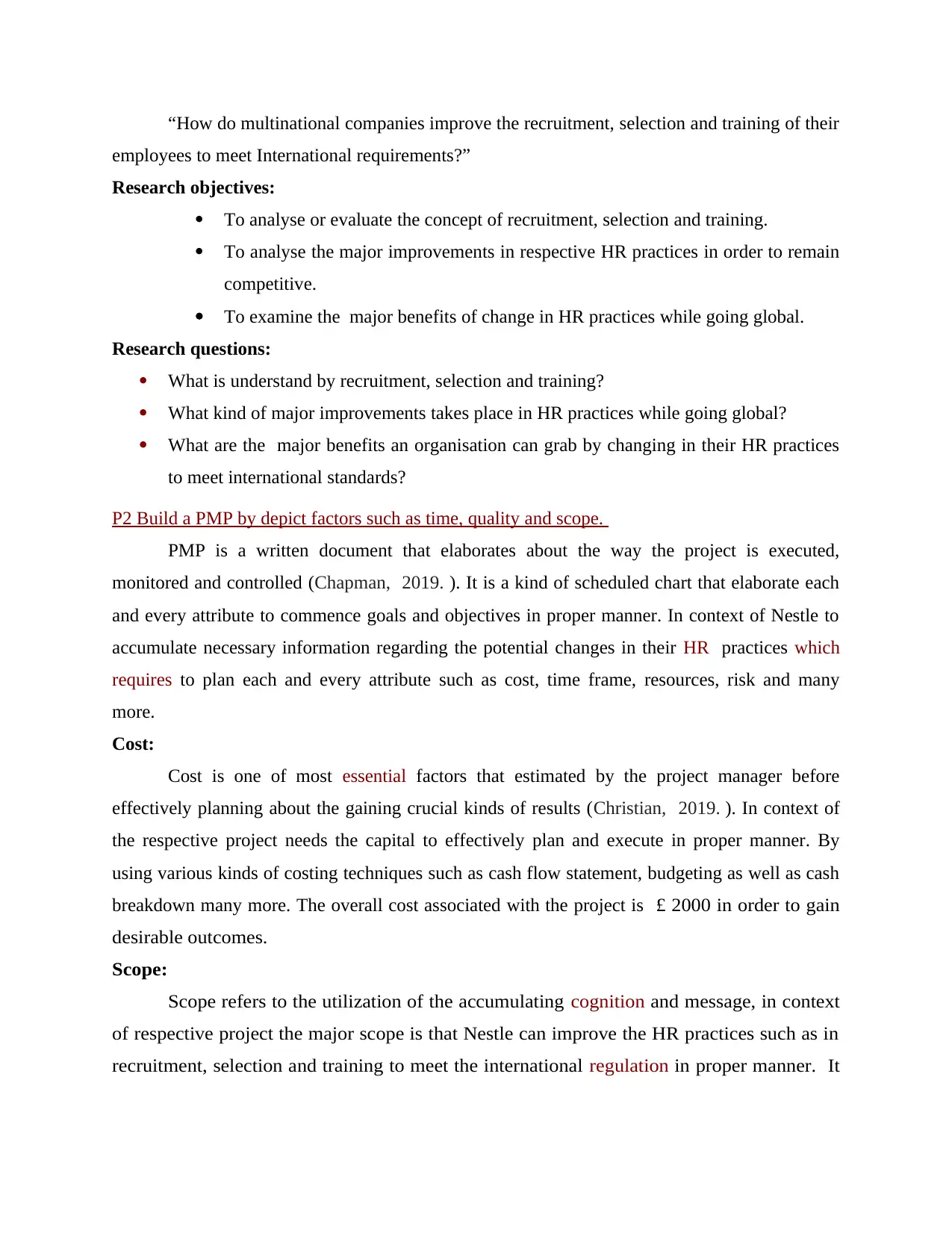
“How do multinational companies improve the recruitment, selection and training of their
employees to meet International requirements?”
Research objectives:
To analyse or evaluate the concept of recruitment, selection and training.
To analyse the major improvements in respective HR practices in order to remain
competitive.
To examine the major benefits of change in HR practices while going global.
Research questions:
What is understand by recruitment, selection and training?
What kind of major improvements takes place in HR practices while going global?
What are the major benefits an organisation can grab by changing in their HR practices
to meet international standards?
P2 Build a PMP by depict factors such as time, quality and scope.
PMP is a written document that elaborates about the way the project is executed,
monitored and controlled (Chapman, 2019. ). It is a kind of scheduled chart that elaborate each
and every attribute to commence goals and objectives in proper manner. In context of Nestle to
accumulate necessary information regarding the potential changes in their HR practices which
requires to plan each and every attribute such as cost, time frame, resources, risk and many
more.
Cost:
Cost is one of most essential factors that estimated by the project manager before
effectively planning about the gaining crucial kinds of results (Christian, 2019. ). In context of
the respective project needs the capital to effectively plan and execute in proper manner. By
using various kinds of costing techniques such as cash flow statement, budgeting as well as cash
breakdown many more. The overall cost associated with the project is £ 2000 in order to gain
desirable outcomes.
Scope:
Scope refers to the utilization of the accumulating cognition and message, in context
of respective project the major scope is that Nestle can improve the HR practices such as in
recruitment, selection and training to meet the international regulation in proper manner. It
employees to meet International requirements?”
Research objectives:
To analyse or evaluate the concept of recruitment, selection and training.
To analyse the major improvements in respective HR practices in order to remain
competitive.
To examine the major benefits of change in HR practices while going global.
Research questions:
What is understand by recruitment, selection and training?
What kind of major improvements takes place in HR practices while going global?
What are the major benefits an organisation can grab by changing in their HR practices
to meet international standards?
P2 Build a PMP by depict factors such as time, quality and scope.
PMP is a written document that elaborates about the way the project is executed,
monitored and controlled (Chapman, 2019. ). It is a kind of scheduled chart that elaborate each
and every attribute to commence goals and objectives in proper manner. In context of Nestle to
accumulate necessary information regarding the potential changes in their HR practices which
requires to plan each and every attribute such as cost, time frame, resources, risk and many
more.
Cost:
Cost is one of most essential factors that estimated by the project manager before
effectively planning about the gaining crucial kinds of results (Christian, 2019. ). In context of
the respective project needs the capital to effectively plan and execute in proper manner. By
using various kinds of costing techniques such as cash flow statement, budgeting as well as cash
breakdown many more. The overall cost associated with the project is £ 2000 in order to gain
desirable outcomes.
Scope:
Scope refers to the utilization of the accumulating cognition and message, in context
of respective project the major scope is that Nestle can improve the HR practices such as in
recruitment, selection and training to meet the international regulation in proper manner. It
Paraphrase This Document
Need a fresh take? Get an instant paraphrase of this document with our AI Paraphraser
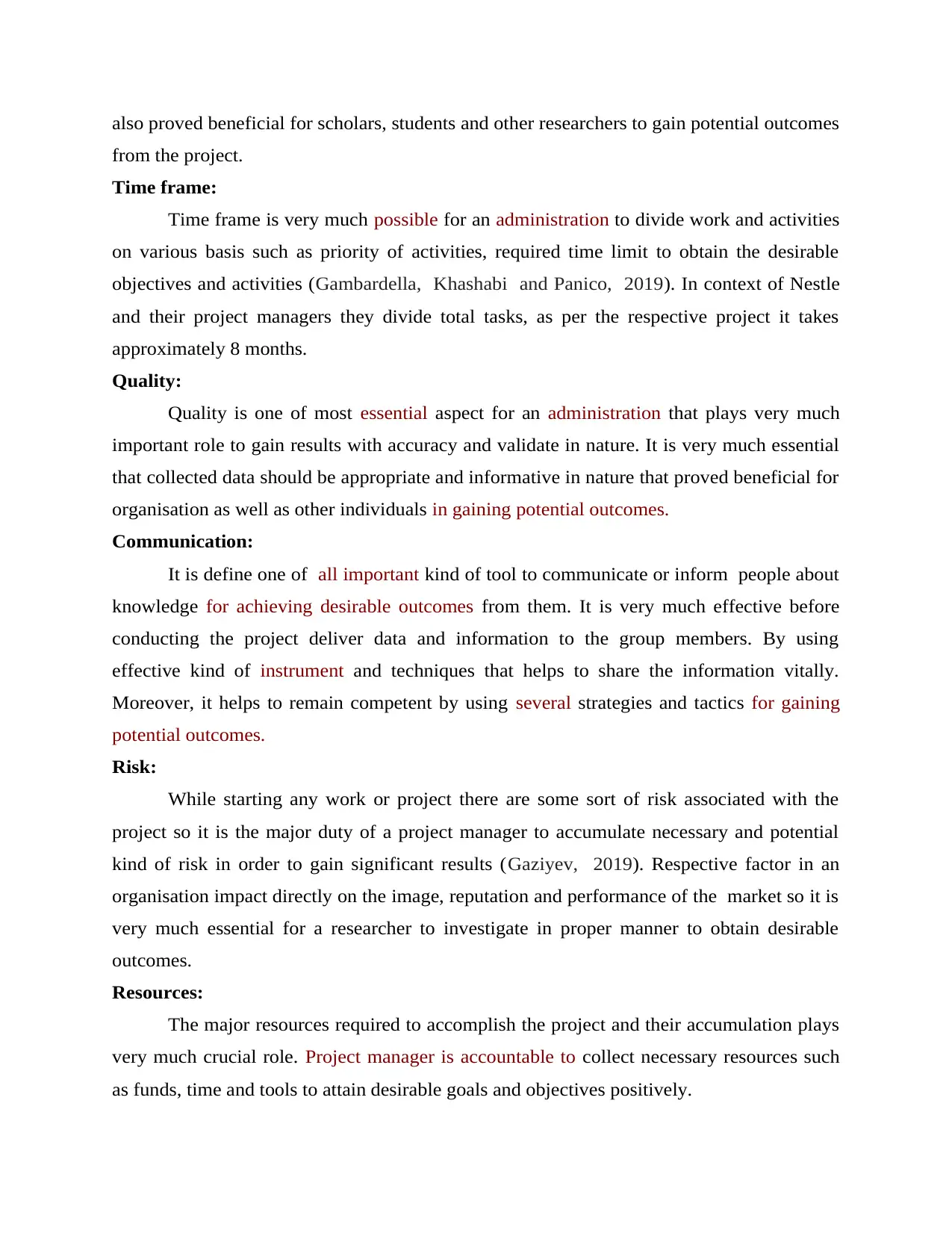
also proved beneficial for scholars, students and other researchers to gain potential outcomes
from the project.
Time frame:
Time frame is very much possible for an administration to divide work and activities
on various basis such as priority of activities, required time limit to obtain the desirable
objectives and activities (Gambardella, Khashabi and Panico, 2019). In context of Nestle
and their project managers they divide total tasks, as per the respective project it takes
approximately 8 months.
Quality:
Quality is one of most essential aspect for an administration that plays very much
important role to gain results with accuracy and validate in nature. It is very much essential
that collected data should be appropriate and informative in nature that proved beneficial for
organisation as well as other individuals in gaining potential outcomes.
Communication:
It is define one of all important kind of tool to communicate or inform people about
knowledge for achieving desirable outcomes from them. It is very much effective before
conducting the project deliver data and information to the group members. By using
effective kind of instrument and techniques that helps to share the information vitally.
Moreover, it helps to remain competent by using several strategies and tactics for gaining
potential outcomes.
Risk:
While starting any work or project there are some sort of risk associated with the
project so it is the major duty of a project manager to accumulate necessary and potential
kind of risk in order to gain significant results (Gaziyev, 2019). Respective factor in an
organisation impact directly on the image, reputation and performance of the market so it is
very much essential for a researcher to investigate in proper manner to obtain desirable
outcomes.
Resources:
The major resources required to accomplish the project and their accumulation plays
very much crucial role. Project manager is accountable to collect necessary resources such
as funds, time and tools to attain desirable goals and objectives positively.
from the project.
Time frame:
Time frame is very much possible for an administration to divide work and activities
on various basis such as priority of activities, required time limit to obtain the desirable
objectives and activities (Gambardella, Khashabi and Panico, 2019). In context of Nestle
and their project managers they divide total tasks, as per the respective project it takes
approximately 8 months.
Quality:
Quality is one of most essential aspect for an administration that plays very much
important role to gain results with accuracy and validate in nature. It is very much essential
that collected data should be appropriate and informative in nature that proved beneficial for
organisation as well as other individuals in gaining potential outcomes.
Communication:
It is define one of all important kind of tool to communicate or inform people about
knowledge for achieving desirable outcomes from them. It is very much effective before
conducting the project deliver data and information to the group members. By using
effective kind of instrument and techniques that helps to share the information vitally.
Moreover, it helps to remain competent by using several strategies and tactics for gaining
potential outcomes.
Risk:
While starting any work or project there are some sort of risk associated with the
project so it is the major duty of a project manager to accumulate necessary and potential
kind of risk in order to gain significant results (Gaziyev, 2019). Respective factor in an
organisation impact directly on the image, reputation and performance of the market so it is
very much essential for a researcher to investigate in proper manner to obtain desirable
outcomes.
Resources:
The major resources required to accomplish the project and their accumulation plays
very much crucial role. Project manager is accountable to collect necessary resources such
as funds, time and tools to attain desirable goals and objectives positively.
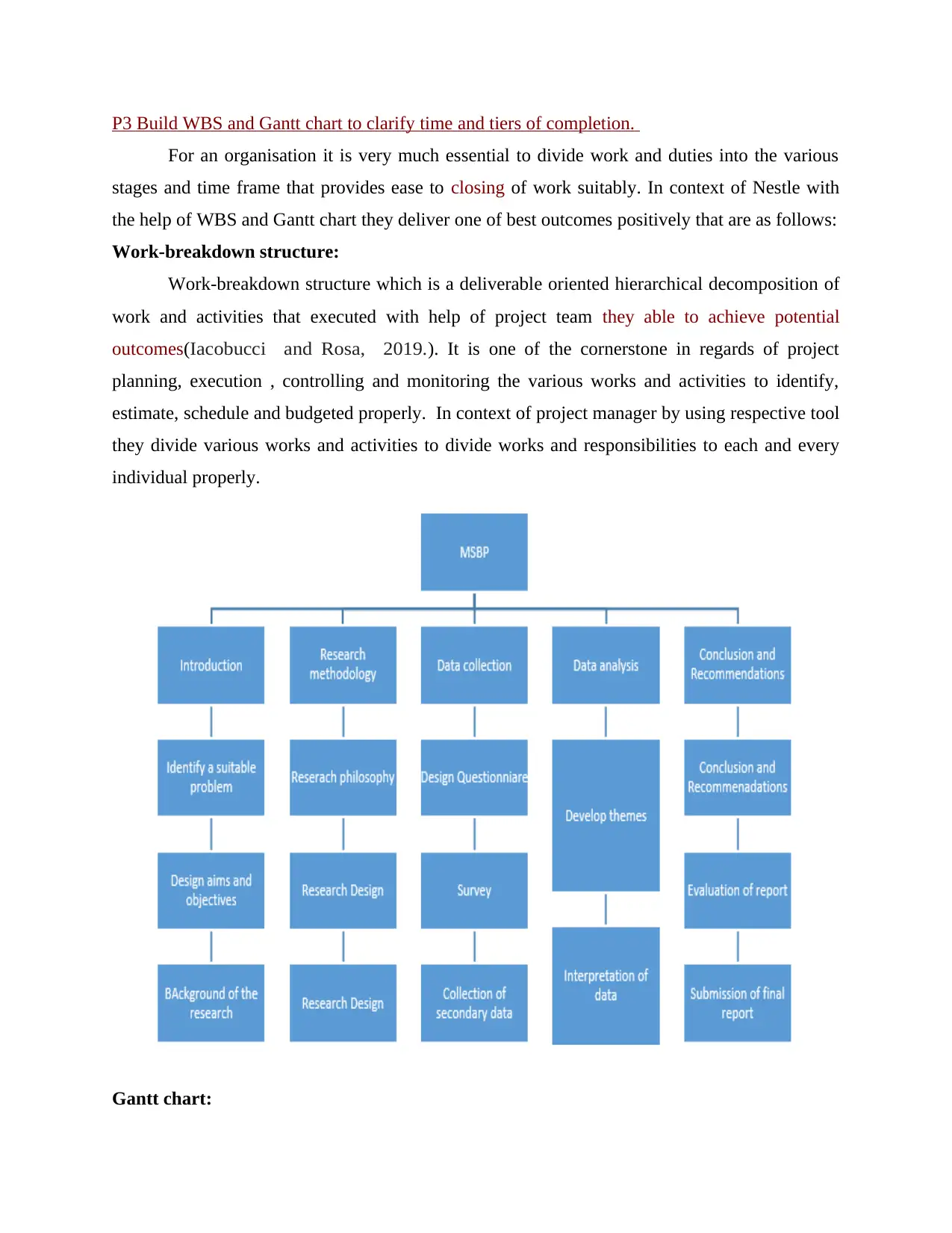
P3 Build WBS and Gantt chart to clarify time and tiers of completion.
For an organisation it is very much essential to divide work and duties into the various
stages and time frame that provides ease to closing of work suitably. In context of Nestle with
the help of WBS and Gantt chart they deliver one of best outcomes positively that are as follows:
Work-breakdown structure:
Work-breakdown structure which is a deliverable oriented hierarchical decomposition of
work and activities that executed with help of project team they able to achieve potential
outcomes( Iacobucci and Rosa, 2019.). It is one of the cornerstone in regards of project
planning, execution , controlling and monitoring the various works and activities to identify,
estimate, schedule and budgeted properly. In context of project manager by using respective tool
they divide various works and activities to divide works and responsibilities to each and every
individual properly.
Gantt chart:
For an organisation it is very much essential to divide work and duties into the various
stages and time frame that provides ease to closing of work suitably. In context of Nestle with
the help of WBS and Gantt chart they deliver one of best outcomes positively that are as follows:
Work-breakdown structure:
Work-breakdown structure which is a deliverable oriented hierarchical decomposition of
work and activities that executed with help of project team they able to achieve potential
outcomes( Iacobucci and Rosa, 2019.). It is one of the cornerstone in regards of project
planning, execution , controlling and monitoring the various works and activities to identify,
estimate, schedule and budgeted properly. In context of project manager by using respective tool
they divide various works and activities to divide works and responsibilities to each and every
individual properly.
Gantt chart:
⊘ This is a preview!⊘
Do you want full access?
Subscribe today to unlock all pages.

Trusted by 1+ million students worldwide
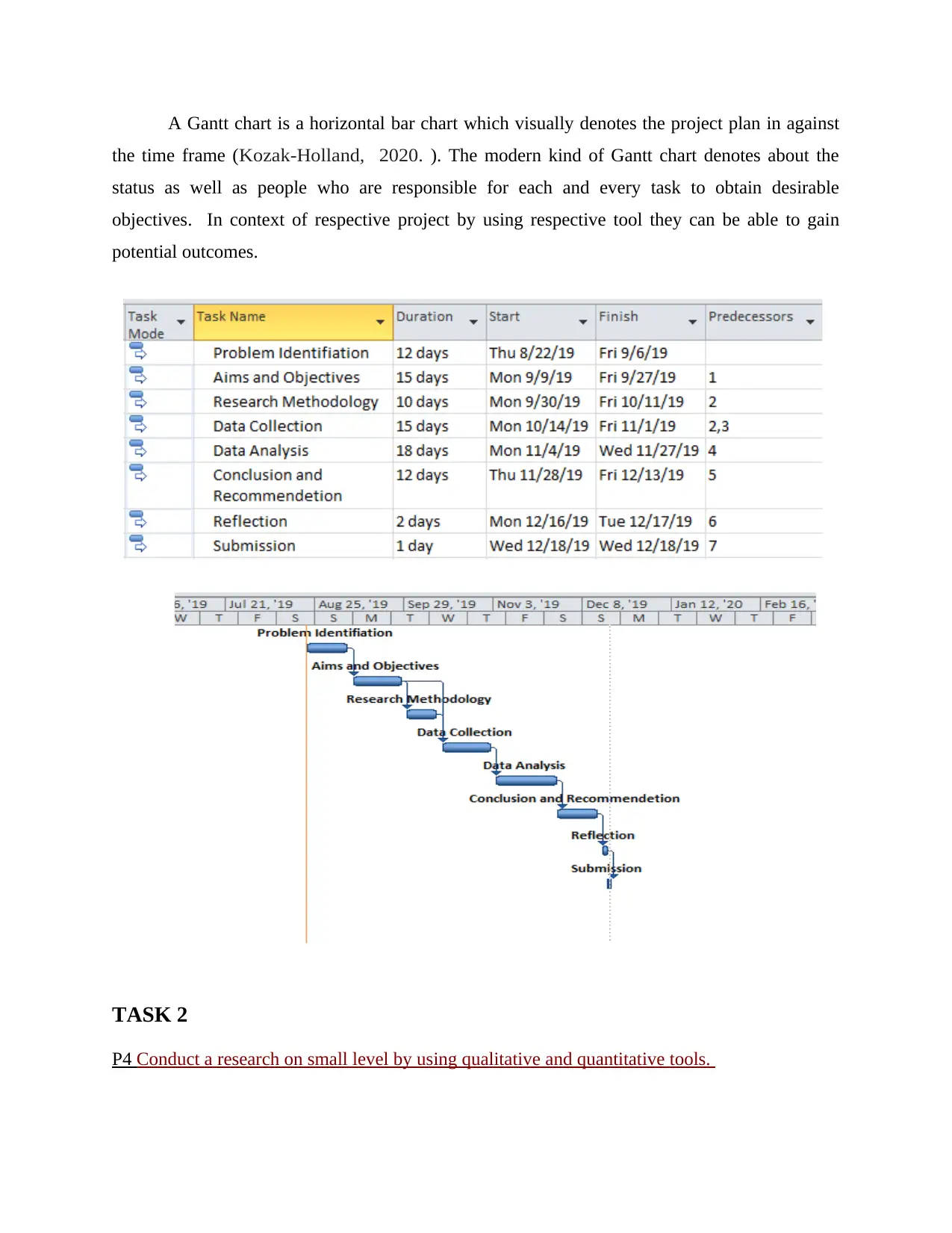
A Gantt chart is a horizontal bar chart which visually denotes the project plan in against
the time frame ( Kozak-Holland, 2020. ). The modern kind of Gantt chart denotes about the
status as well as people who are responsible for each and every task to obtain desirable
objectives. In context of respective project by using respective tool they can be able to gain
potential outcomes.
TASK 2
P4 Conduct a research on small level by using qualitative and quantitative tools.
the time frame ( Kozak-Holland, 2020. ). The modern kind of Gantt chart denotes about the
status as well as people who are responsible for each and every task to obtain desirable
objectives. In context of respective project by using respective tool they can be able to gain
potential outcomes.
TASK 2
P4 Conduct a research on small level by using qualitative and quantitative tools.
Paraphrase This Document
Need a fresh take? Get an instant paraphrase of this document with our AI Paraphraser
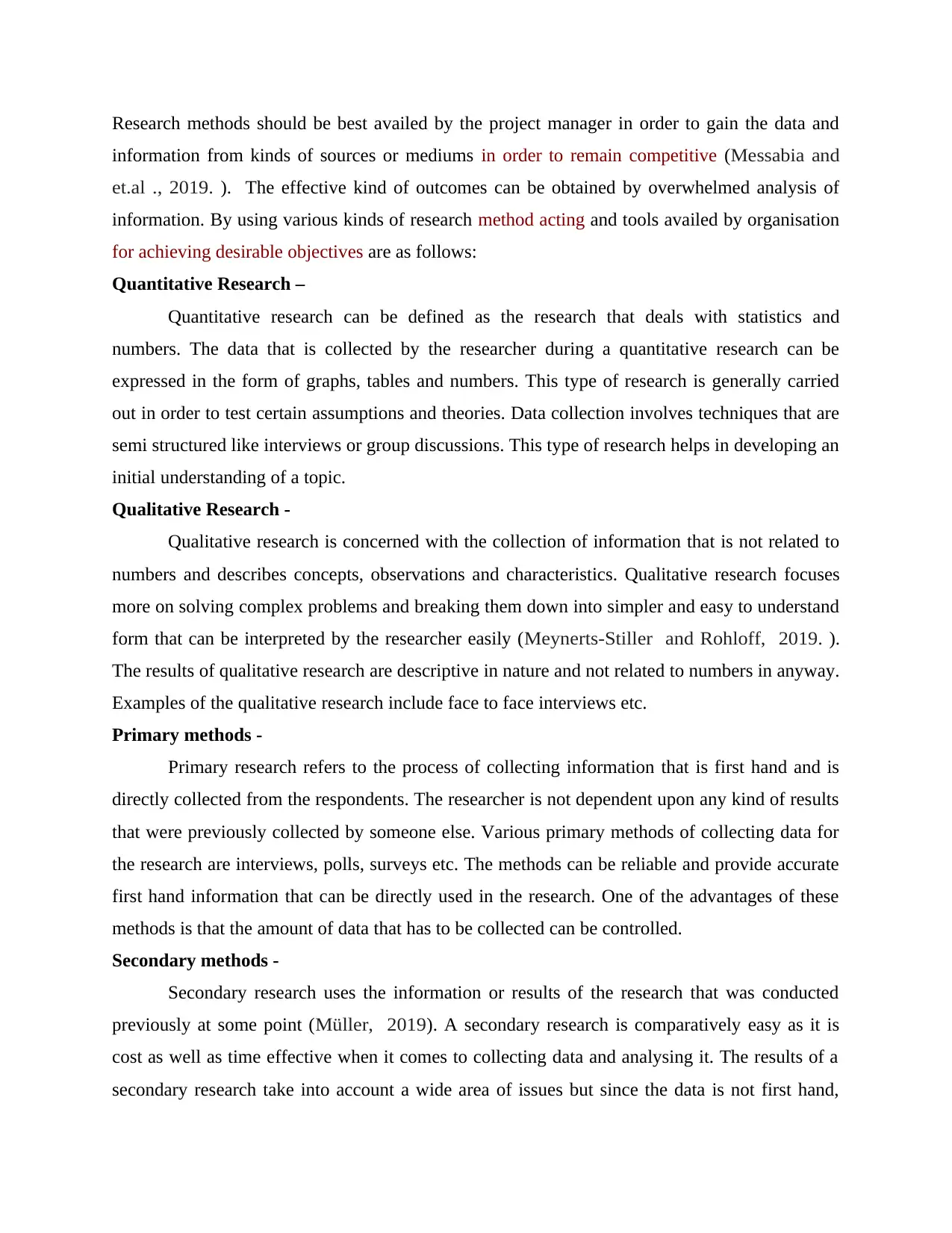
Research methods should be best availed by the project manager in order to gain the data and
information from kinds of sources or mediums in order to remain competitive ( Messabia and
et.al ., 2019. ). The effective kind of outcomes can be obtained by overwhelmed analysis of
information. By using various kinds of research method acting and tools availed by organisation
for achieving desirable objectives are as follows:
Quantitative Research –
Quantitative research can be defined as the research that deals with statistics and
numbers. The data that is collected by the researcher during a quantitative research can be
expressed in the form of graphs, tables and numbers. This type of research is generally carried
out in order to test certain assumptions and theories. Data collection involves techniques that are
semi structured like interviews or group discussions. This type of research helps in developing an
initial understanding of a topic.
Qualitative Research -
Qualitative research is concerned with the collection of information that is not related to
numbers and describes concepts, observations and characteristics. Qualitative research focuses
more on solving complex problems and breaking them down into simpler and easy to understand
form that can be interpreted by the researcher easily ( Meynerts-Stiller and Rohloff, 2019. ).
The results of qualitative research are descriptive in nature and not related to numbers in anyway.
Examples of the qualitative research include face to face interviews etc.
Primary methods -
Primary research refers to the process of collecting information that is first hand and is
directly collected from the respondents. The researcher is not dependent upon any kind of results
that were previously collected by someone else. Various primary methods of collecting data for
the research are interviews, polls, surveys etc. The methods can be reliable and provide accurate
first hand information that can be directly used in the research. One of the advantages of these
methods is that the amount of data that has to be collected can be controlled.
Secondary methods -
Secondary research uses the information or results of the research that was conducted
previously at some point ( Müller, 2019). A secondary research is comparatively easy as it is
cost as well as time effective when it comes to collecting data and analysing it. The results of a
secondary research take into account a wide area of issues but since the data is not first hand,
information from kinds of sources or mediums in order to remain competitive ( Messabia and
et.al ., 2019. ). The effective kind of outcomes can be obtained by overwhelmed analysis of
information. By using various kinds of research method acting and tools availed by organisation
for achieving desirable objectives are as follows:
Quantitative Research –
Quantitative research can be defined as the research that deals with statistics and
numbers. The data that is collected by the researcher during a quantitative research can be
expressed in the form of graphs, tables and numbers. This type of research is generally carried
out in order to test certain assumptions and theories. Data collection involves techniques that are
semi structured like interviews or group discussions. This type of research helps in developing an
initial understanding of a topic.
Qualitative Research -
Qualitative research is concerned with the collection of information that is not related to
numbers and describes concepts, observations and characteristics. Qualitative research focuses
more on solving complex problems and breaking them down into simpler and easy to understand
form that can be interpreted by the researcher easily ( Meynerts-Stiller and Rohloff, 2019. ).
The results of qualitative research are descriptive in nature and not related to numbers in anyway.
Examples of the qualitative research include face to face interviews etc.
Primary methods -
Primary research refers to the process of collecting information that is first hand and is
directly collected from the respondents. The researcher is not dependent upon any kind of results
that were previously collected by someone else. Various primary methods of collecting data for
the research are interviews, polls, surveys etc. The methods can be reliable and provide accurate
first hand information that can be directly used in the research. One of the advantages of these
methods is that the amount of data that has to be collected can be controlled.
Secondary methods -
Secondary research uses the information or results of the research that was conducted
previously at some point ( Müller, 2019). A secondary research is comparatively easy as it is
cost as well as time effective when it comes to collecting data and analysing it. The results of a
secondary research take into account a wide area of issues but since the data is not first hand,
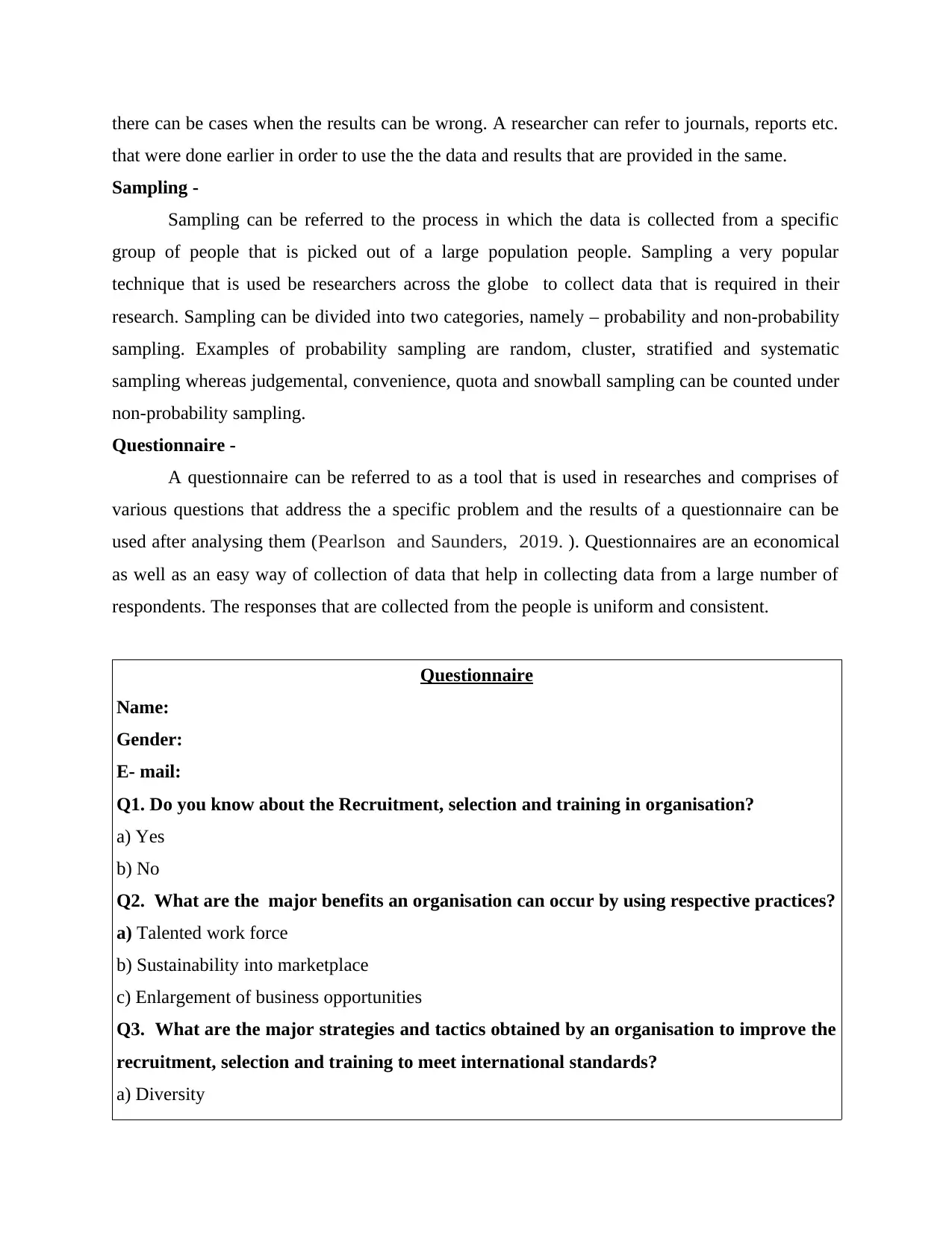
there can be cases when the results can be wrong. A researcher can refer to journals, reports etc.
that were done earlier in order to use the the data and results that are provided in the same.
Sampling -
Sampling can be referred to the process in which the data is collected from a specific
group of people that is picked out of a large population people. Sampling a very popular
technique that is used be researchers across the globe to collect data that is required in their
research. Sampling can be divided into two categories, namely – probability and non-probability
sampling. Examples of probability sampling are random, cluster, stratified and systematic
sampling whereas judgemental, convenience, quota and snowball sampling can be counted under
non-probability sampling.
Questionnaire -
A questionnaire can be referred to as a tool that is used in researches and comprises of
various questions that address the a specific problem and the results of a questionnaire can be
used after analysing them ( Pearlson and Saunders, 2019. ). Questionnaires are an economical
as well as an easy way of collection of data that help in collecting data from a large number of
respondents. The responses that are collected from the people is uniform and consistent.
Questionnaire
Name:
Gender:
E- mail:
Q1. Do you know about the Recruitment, selection and training in organisation?
a) Yes
b) No
Q2. What are the major benefits an organisation can occur by using respective practices?
a) Talented work force
b) Sustainability into marketplace
c) Enlargement of business opportunities
Q3. What are the major strategies and tactics obtained by an organisation to improve the
recruitment, selection and training to meet international standards?
a) Diversity
that were done earlier in order to use the the data and results that are provided in the same.
Sampling -
Sampling can be referred to the process in which the data is collected from a specific
group of people that is picked out of a large population people. Sampling a very popular
technique that is used be researchers across the globe to collect data that is required in their
research. Sampling can be divided into two categories, namely – probability and non-probability
sampling. Examples of probability sampling are random, cluster, stratified and systematic
sampling whereas judgemental, convenience, quota and snowball sampling can be counted under
non-probability sampling.
Questionnaire -
A questionnaire can be referred to as a tool that is used in researches and comprises of
various questions that address the a specific problem and the results of a questionnaire can be
used after analysing them ( Pearlson and Saunders, 2019. ). Questionnaires are an economical
as well as an easy way of collection of data that help in collecting data from a large number of
respondents. The responses that are collected from the people is uniform and consistent.
Questionnaire
Name:
Gender:
E- mail:
Q1. Do you know about the Recruitment, selection and training in organisation?
a) Yes
b) No
Q2. What are the major benefits an organisation can occur by using respective practices?
a) Talented work force
b) Sustainability into marketplace
c) Enlargement of business opportunities
Q3. What are the major strategies and tactics obtained by an organisation to improve the
recruitment, selection and training to meet international standards?
a) Diversity
⊘ This is a preview!⊘
Do you want full access?
Subscribe today to unlock all pages.

Trusted by 1+ million students worldwide
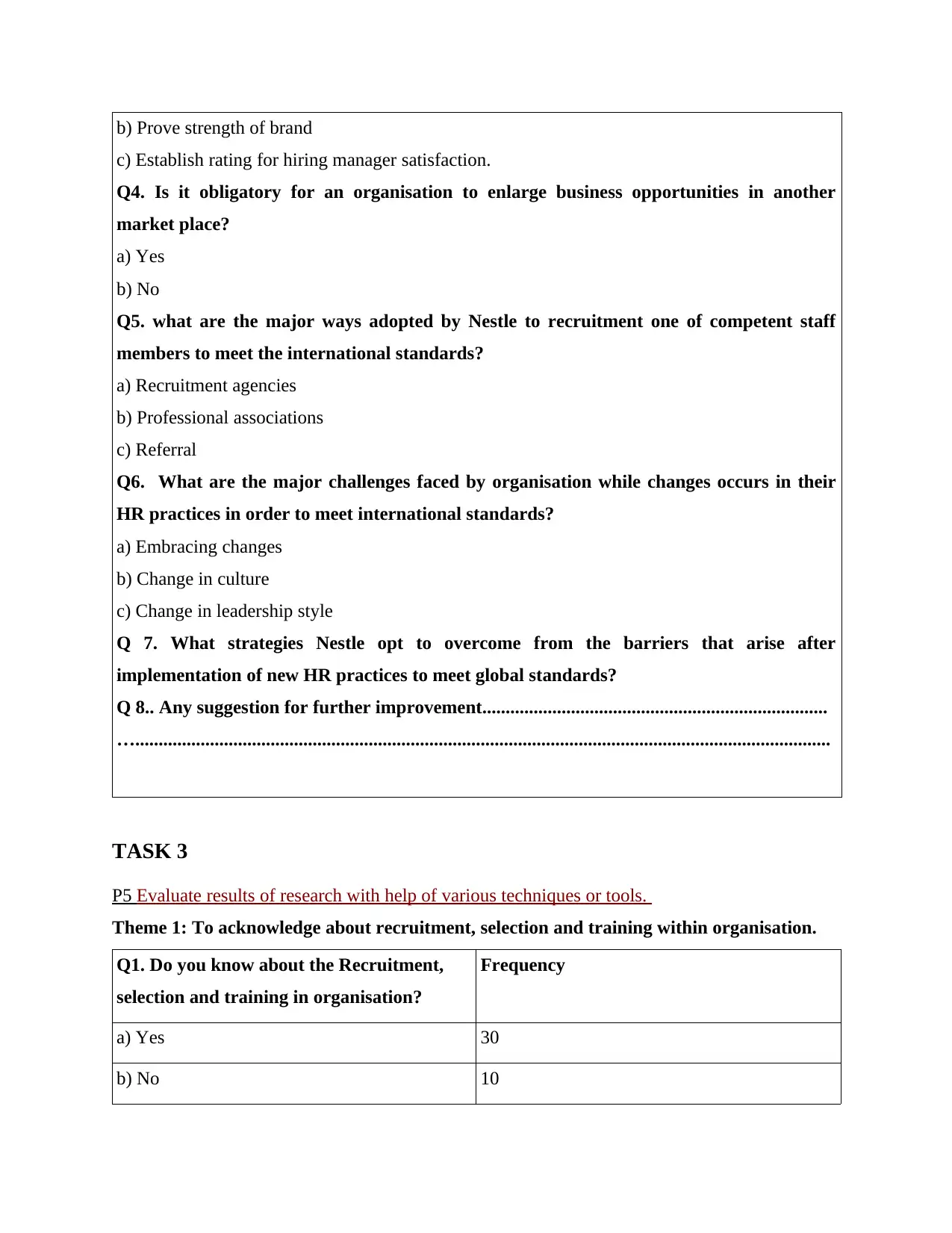
b) Prove strength of brand
c) Establish rating for hiring manager satisfaction.
Q4. Is it obligatory for an organisation to enlarge business opportunities in another
market place?
a) Yes
b) No
Q5. what are the major ways adopted by Nestle to recruitment one of competent staff
members to meet the international standards?
a) Recruitment agencies
b) Professional associations
c) Referral
Q6. What are the major challenges faced by organisation while changes occurs in their
HR practices in order to meet international standards?
a) Embracing changes
b) Change in culture
c) Change in leadership style
Q 7. What strategies Nestle opt to overcome from the barriers that arise after
implementation of new HR practices to meet global standards?
Q 8.. Any suggestion for further improvement..........................................................................
….....................................................................................................................................................
TASK 3
P5 Evaluate results of research with help of various techniques or tools.
Theme 1: To acknowledge about recruitment, selection and training within organisation.
Q1. Do you know about the Recruitment,
selection and training in organisation?
Frequency
a) Yes 30
b) No 10
c) Establish rating for hiring manager satisfaction.
Q4. Is it obligatory for an organisation to enlarge business opportunities in another
market place?
a) Yes
b) No
Q5. what are the major ways adopted by Nestle to recruitment one of competent staff
members to meet the international standards?
a) Recruitment agencies
b) Professional associations
c) Referral
Q6. What are the major challenges faced by organisation while changes occurs in their
HR practices in order to meet international standards?
a) Embracing changes
b) Change in culture
c) Change in leadership style
Q 7. What strategies Nestle opt to overcome from the barriers that arise after
implementation of new HR practices to meet global standards?
Q 8.. Any suggestion for further improvement..........................................................................
….....................................................................................................................................................
TASK 3
P5 Evaluate results of research with help of various techniques or tools.
Theme 1: To acknowledge about recruitment, selection and training within organisation.
Q1. Do you know about the Recruitment,
selection and training in organisation?
Frequency
a) Yes 30
b) No 10
Paraphrase This Document
Need a fresh take? Get an instant paraphrase of this document with our AI Paraphraser
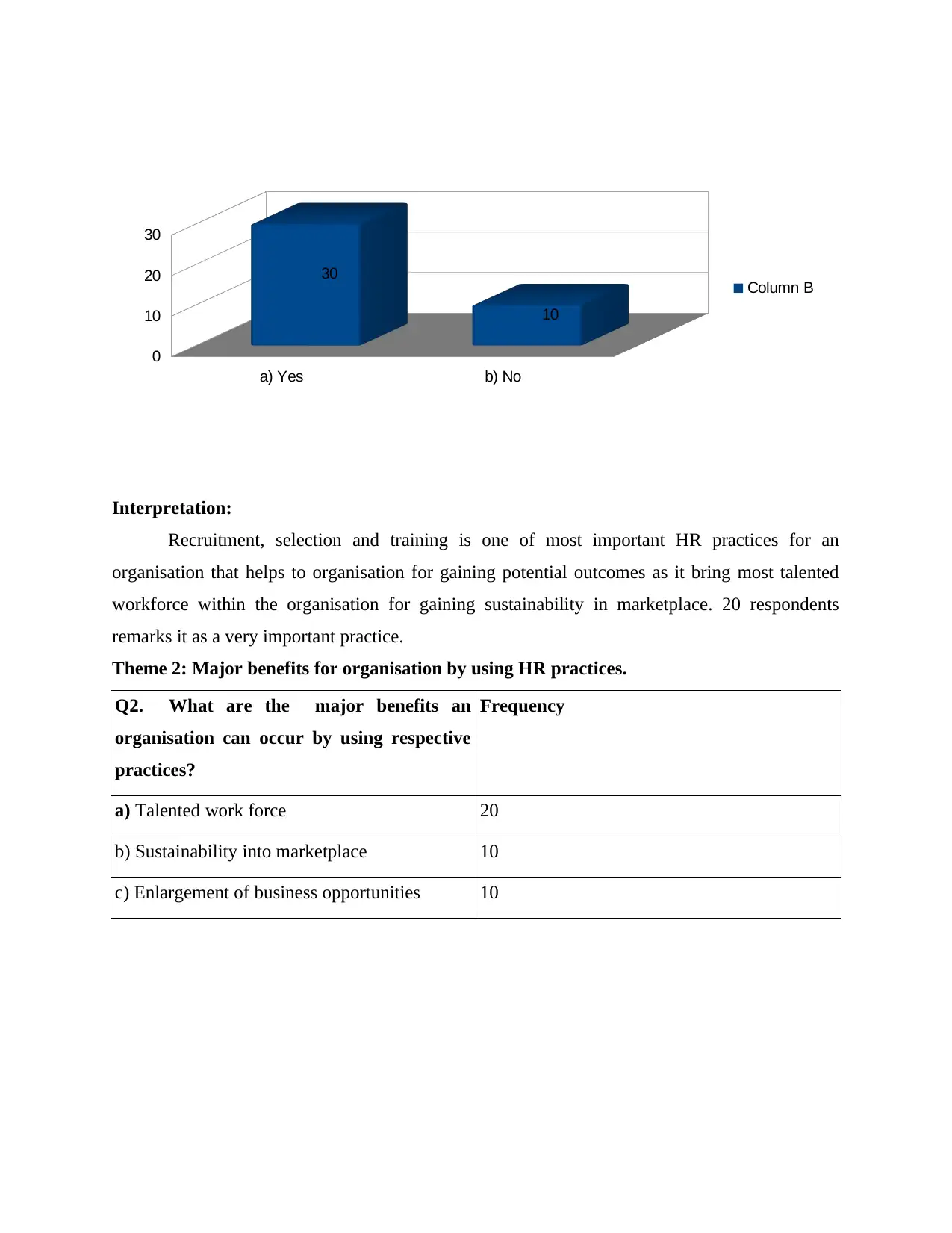
Interpretation:
Recruitment, selection and training is one of most important HR practices for an
organisation that helps to organisation for gaining potential outcomes as it bring most talented
workforce within the organisation for gaining sustainability in marketplace. 20 respondents
remarks it as a very important practice.
Theme 2: Major benefits for organisation by using HR practices.
Q2. What are the major benefits an
organisation can occur by using respective
practices?
Frequency
a) Talented work force 20
b) Sustainability into marketplace 10
c) Enlargement of business opportunities 10
a) Yes b) No
0
10
20
30
30
10
Column B
Recruitment, selection and training is one of most important HR practices for an
organisation that helps to organisation for gaining potential outcomes as it bring most talented
workforce within the organisation for gaining sustainability in marketplace. 20 respondents
remarks it as a very important practice.
Theme 2: Major benefits for organisation by using HR practices.
Q2. What are the major benefits an
organisation can occur by using respective
practices?
Frequency
a) Talented work force 20
b) Sustainability into marketplace 10
c) Enlargement of business opportunities 10
a) Yes b) No
0
10
20
30
30
10
Column B
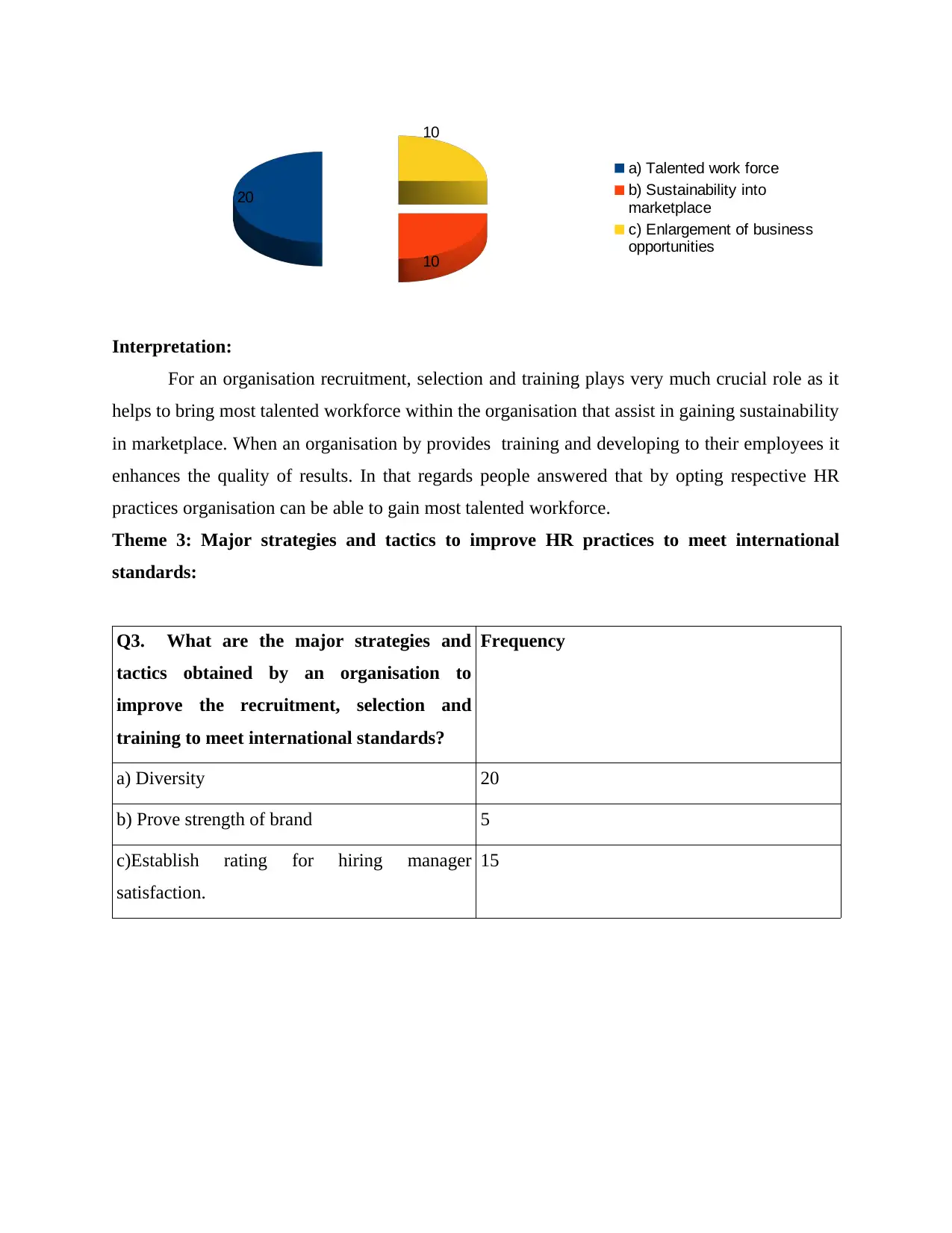
Interpretation:
For an organisation recruitment, selection and training plays very much crucial role as it
helps to bring most talented workforce within the organisation that assist in gaining sustainability
in marketplace. When an organisation by provides training and developing to their employees it
enhances the quality of results. In that regards people answered that by opting respective HR
practices organisation can be able to gain most talented workforce.
Theme 3: Major strategies and tactics to improve HR practices to meet international
standards:
Q3. What are the major strategies and
tactics obtained by an organisation to
improve the recruitment, selection and
training to meet international standards?
Frequency
a) Diversity 20
b) Prove strength of brand 5
c)Establish rating for hiring manager
satisfaction.
15
20
10
10
a) Talented work force
b) Sustainability into
marketplace
c) Enlargement of business
opportunities
For an organisation recruitment, selection and training plays very much crucial role as it
helps to bring most talented workforce within the organisation that assist in gaining sustainability
in marketplace. When an organisation by provides training and developing to their employees it
enhances the quality of results. In that regards people answered that by opting respective HR
practices organisation can be able to gain most talented workforce.
Theme 3: Major strategies and tactics to improve HR practices to meet international
standards:
Q3. What are the major strategies and
tactics obtained by an organisation to
improve the recruitment, selection and
training to meet international standards?
Frequency
a) Diversity 20
b) Prove strength of brand 5
c)Establish rating for hiring manager
satisfaction.
15
20
10
10
a) Talented work force
b) Sustainability into
marketplace
c) Enlargement of business
opportunities
⊘ This is a preview!⊘
Do you want full access?
Subscribe today to unlock all pages.

Trusted by 1+ million students worldwide
1 out of 24
Related Documents
Your All-in-One AI-Powered Toolkit for Academic Success.
+13062052269
info@desklib.com
Available 24*7 on WhatsApp / Email
![[object Object]](/_next/static/media/star-bottom.7253800d.svg)
Unlock your academic potential
Copyright © 2020–2025 A2Z Services. All Rights Reserved. Developed and managed by ZUCOL.





